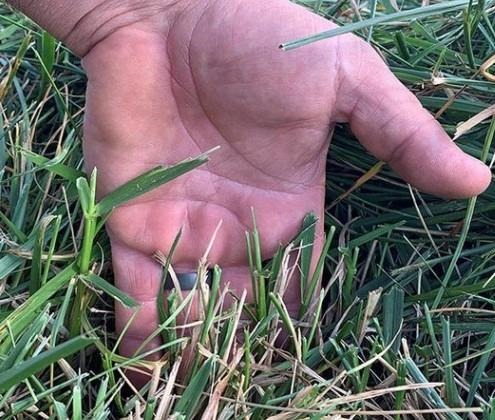By Andrew Frankenfield
The field in the photo was cut June 9th and baled as dry hay June 10th yielding 2.5 tons per acre. It received 50 units of nitrogen just before 0.4" of rain a week later. In a 6-week period after cutting it received 3" of rain total. Every week it received some rain, mostly less than a 1/2" per week and even less recently as the temperature soared into the 90s with a moisture zapping wind most days. This field is predominantly tall fescue with some orchardgrass. The fescue is taking the heat and drought harder than the orchardgrass. It is short, thin, and curled, the orchardgrass is significantly taller but there aren’t enough of them to help the yield. What do we do with a field like this at this time?
Some things to consider for drought-stressed grass hay fields are the type of grass, the estimated yield, the forecast, the value of the hay, the cost of making the hay and fertility. Orchardgrass and tall fescue are probably the most drought tolerant grass species grown in Pennsylvania. Their growth will slow down but when adequate moisture returns, they will regrow quickly with little stand loss. Just like grazing, be careful not to mow too short during a drought, leave 3-4” of stubble height so the plant has energy reserves to regrow. How much growth is too much to leave and impact the quality of the next cutting? That is a personal preference. Recently I baled a field of 2nd cutting orchardgrass that yielded 900 pounds of 10% moisture dry hay to the acre. We felt like that was enough yield of very good quality to justify cutting and baling. We felt it was too much to leave on the field for another week or two and see what happened with the weather and it was already starting to get a few brown tips on the leaves.
How much does it cost to cut, rake and bale a thin field of 2nd cutting grass hay? We don’t have any 2022 custom rates for PA but Iowa has some comparable numbers. Their averages are mowing/conditioning=$16.20/a, raking=$7.65/a, $0.85 per small square bale and $12.90 per large square bale. I think most of those numbers are low except for the large square baling price is in the ballpark. Let's use $20/acre for mowing, $10/acre for raking and $1.25/small square bale and $12/large square bale (3'x3'x7.5')
Consider a 1 ton yield (40# small bales and 667 pound large square bales)
Small bales – mow $20, rake $10, bale $62.5 (1.25 x 50) = $92/acre to harvest not including handling
Large Squares - mow $20, rake $10, bale $36 (3 x 12) = $66/acre to harvest not including handling
Consider a 1/2 ton yield (40# small bales and 667 pound large square bales)
Small bales - mow $20, rake $10, bale $31 (1.25 x 25) = $61 /acre to harvest not including handling
Large Squares mow $20, rake $10, bale $18 (1.5 x 12) = $48/acre to harvest not including handling

Good mowing height. Photo: Andrew Frankenfield
Fertility Considerations
One ton of grass hay removes 50 units of nitrogen, 15 units of phosphorus, 50 units of potassium from the soil. If you fertilized for a ton or 1.5 tons of hay and you harvest only half of that there will still be some residual fertility remaining for the next cutting. Take that into account when you fertilize for your next cutting. Fertilizer prices have come down some in the past couple months, but it still isn’t cheap. Applying fertilizer to a hay field that has mostly gone dormant due to drought is probably not a good idea. At this time, it is best to plan how much fertilizer you will apply when the rains return and apply that once we see the weather pattern change that brings more frequent rainfall.
Grass is very responsive to rainfall; we still have an opportunity for decent cutting in September if the rains return in August. Don't lose hope. It will rain again before too long and the grass will regrow.
Source : psu.edu